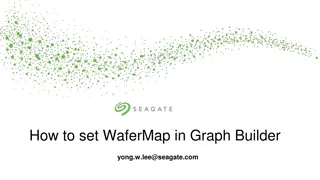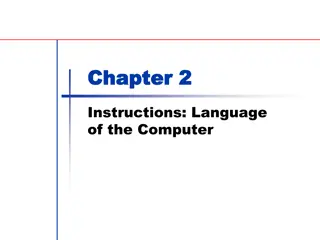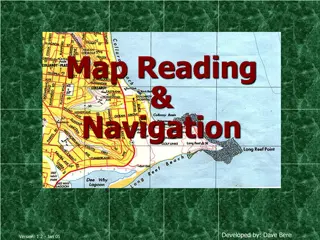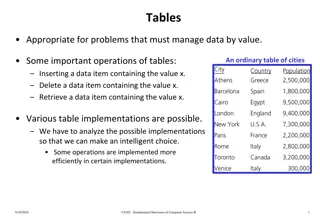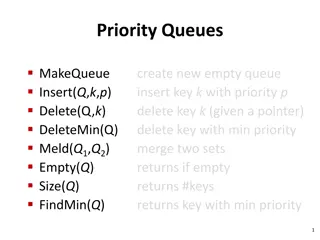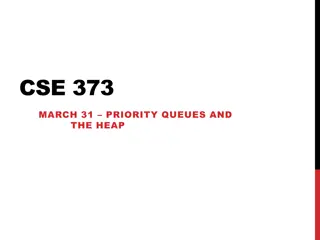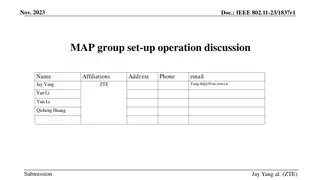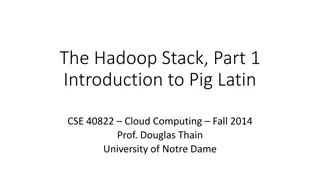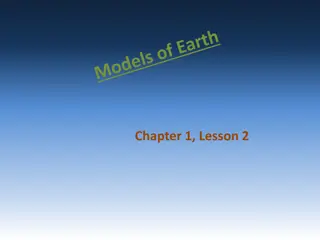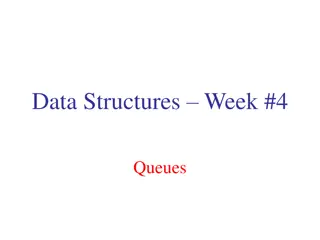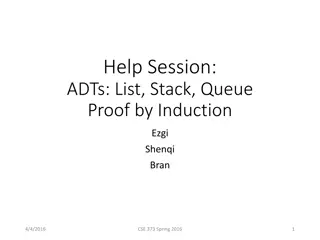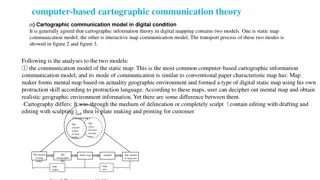Review of Set/Map Operations and Implementations
Set and map operations like insert, remove, find, and get are discussed in the context of binary search trees, hash tables, and tries. The cost of comparison, search complexities, and trie structures for efficient key retrieval are explained. Additionally, the concept of shared paths in tries is highlighted, demonstrating a unique approach to storing and searching keys.
Download Presentation

Please find below an Image/Link to download the presentation.
The content on the website is provided AS IS for your information and personal use only. It may not be sold, licensed, or shared on other websites without obtaining consent from the author.If you encounter any issues during the download, it is possible that the publisher has removed the file from their server.
You are allowed to download the files provided on this website for personal or commercial use, subject to the condition that they are used lawfully. All files are the property of their respective owners.
The content on the website is provided AS IS for your information and personal use only. It may not be sold, licensed, or shared on other websites without obtaining consent from the author.
E N D
Presentation Transcript
1 CSCI 104 Tries Mark Redekopp David Kempe Sandra Batista Aaron Cote
2 Review of Set/Map Again Recall the operations a set or map performs Insert(key) Remove(key) find(key) : bool/iterator/pointer Get(key) : value [Map only] We can implement a set or map using a binary search tree Search = O( log(n) ) But what work do we have to do at each node? Compare (i.e. string compare) How much does that cost? Int = O(1) String = O( k ) where k is length of the string Thus, search costs O( k * log(n) ) "help" "hear" "ill" "heap" "held" "in"
3 Review of Set/Map Again We can implement a set or map using a hash table Search = O( 1 ) But what work do we have to do once we hash? Compare (i.e. string compare) How much does that cost? Int = O(1) String = O( k ) where k is length of the string Thus, search costs O( k ) "help" Conversion function 2 0 1 2 3 4 5 healhelp ill hear 3.45
4 Tries Assuming unique keys, can we still achieve O(k) search but not have collisions? O(k) means the time to compare is independent of how many keys (i.e. n) are being stored and only depends on the length of the key Trie(s) (often pronounced "try" or "tries") allow O(k) retrieval Sometimes referred to as a radix tree or prefix tree Consider a trie for the keys "HE", "HEAP", "HEAR", "HELP", "ILL", "IN" - I H H I L N E L N E L L A L A L P R P P R P
5 Tries Rather than each node storing a full key value, each node represents a prefix of the key Highlighted nodes indicate terminal locations For a map we could store the associated value of the key at that terminal location Notice we "share" paths for keys that have a common prefix To search for a key, start at the root consuming one unit (bit, char, etc.) of the key at a time If you end at a terminal node, SUCCESS If you end at a non-terminal node, FAILURE - I H H I L N E L N E L L A L A L P R P P R P
6 Tries To search for a key, start at the root consuming one unit (bit, char, etc.) of the key at a time If you end at a terminal node, SUCCESS If you end at a non-terminal node, FAILURE Examples: Search for "He" Search for "Help" Search for "Head" Search takes O(k) where k = length of key Notice this is the same as a hash table - I H H I L N E L N E L L A L A L P R P P R P For a map, a "value" type could be stored for each terminal node
7 Practice Construct a trie to store the set of words Ten Tent Then Tense Tens Tenth
8 Application: IP Lookups Network routers form the backbone of the Internet Incoming packets contain a destination IP address (128.125.73.60) Routers contain a "routing table" mapping some prefix of destination IP address to output port 128.125.x.x => Output port C 128.209.32.x => Output port B 128.x.x.x => Output port D 132.x.x.x => Output port A Keys = Match the longest prefix Keys are unique Value = Output port Octet 1 Octet 2 Octet 3 Port 10000000 01111101 C 10000000 11010001 00100000 B 10000000 D 10000100 A
9 IP Lookup Trie A binary trie implies that the Left child is for bit '0' Right child is for bit '1' Routing Table: 128.125.x.x => Output port C 128.209.32.x => Output port B 128.209.44.x => Output port D 132.x.x.x => Output port A 1 0 0 0 0 1 0 0 - 0 Octet 1 Octet 2 Octet 3 Port 0 A D 10000000 01111101 C 0 1 10000000 11010001 00100000 B - - 10000000 D 10000100 A C B
10 Structure of Trie Nodes What do we need to store in each node? Depends on how "dense" or "sparse" the tree is? Dense (most characters used) or small size of alphabet of possible key characters Array of child pointers One for each possible character in the alphabet Sparse (Linked) List of children Node needs to store ______ template < class V > struct TrieNode{ V* value; // NULL if non-terminal TrieNode<V>* children[26]; }; V* a b z template < class V > struct TrieNode{ char key; V* value; TrieNode<V>* next; // sibling TrieNode<V>* children; // head ptr }; c s f s c f h r r h
11 Search V* Search consumes one character at a time until The end of the search key If value pointer exists, then the key is present in the map Or no child pointer exists in the TrieNode Insert Search until key is consumed but trie path already exists Set v pointer to value Search until trie path is NULL, extend path adding new TrieNodes and then add value at terminal V* search(char* k, TrieNode<V>* node) { while(*k != '\0' && node != NULL){ node = node->children[*k 'a']; k++; } if(node) return node->v; else return NULL; } k 0x120 h e a r 0x120 \0 void insert(char* k, Value& v) { TrieNode<V>* node = root; while(*k != '\0' && node != NULL){ node = node->children[*k 'a']; k++; } if(node){ node->v = new Value(v); } else { // create new nodes in trie // to extend path // updating root if trie is empty } }
12 Thinking Exercise: Removal How would removal of a key work in a trie and what are the cases you'd have to worry about? Does removal of a key always mean removal of a node? - I H H I L N E L N E L L A If we do remove a node, would it only be one node in the trie? L A L P R P P R P A "value" type could be stored for each non-terminal node
13 Compressed Trie We can reduce the number of nodes and thus storage, by storing substrings in each node If a non-word, non-root node has only one child, combine https://www.cs.usfca.edu/~galles/visualization/RadixTree.html - H I HE A I L N L LL N A LP P R P R
14 Compressed Trie Walk key string based on the length of the substring in the current node and then use the next key string character to choose the child node Key is not present if key string characters are exhausted before substring in node or no corresponding child entry Examples: 'H', 'HERD' - H I HE A I L N L LL N A LP P R P R
15 Practice Construct a compressed trie to store the set of words Ten Tent Then Tense Tens Tenth
16 Prefix Trees (Tries) Review What problem does a prefix tree solve Lookups of keys (and possible associated values) A prefix tree helps us match 1-of-n keys "He" "Help" "Hear" "Heap" "In" "Ill" Here is a slightly different problem: Given a large text string, T, can we find certain substrings or answer other queries about patterns in T A suffix tree (trie) can help here
17 Suffix Trees A suffix tree of a string W is a compressed trie consisting of all possible suffixes of W. Are `issip` or `sipi` substrings?
18 Suffix Trees When W has n characters, the suffix tree has: n leaves, each one representing a single suffix W[i : (n-1)] Every non-leaf node has at least two children Each edge is labelled with a substring of W If e and e are edges out of the same node, then their labels start with different letters. For any root-leaf path, the concatenation of their edge labels is equal to W[i : (n-1)] < n internal nodes O(n) total nodes There is an algorithm (Ukkonen s Algorithm) which can build a suffix tree in linear time.
19 What Have We Learned [Key Point]: Think about all the data structures we've been learning There is almost always a trade-off of memory vs. speed i.e. Space vs. time Most data structures just exploit different points on that time-space tradeoff continuum Often we build a data structure that replicates data and takes a lot of memory space so that we can find data faster



